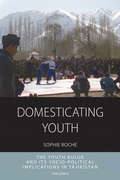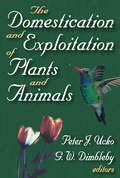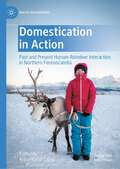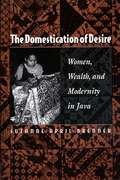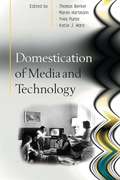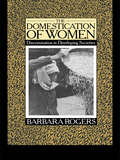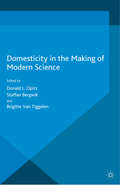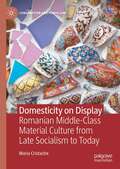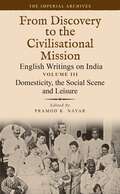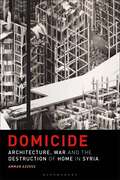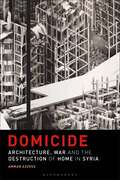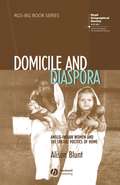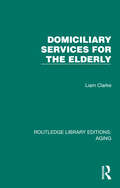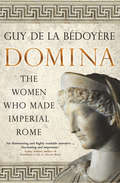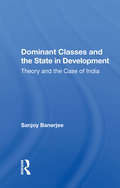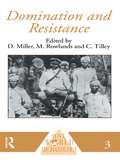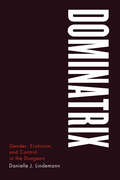- Table View
- List View
Domesticating Youth: Youth Bulges and their Socio-political Implications in Tajikistan (Integration and Conflict Studies #8)
by Sophie RocheMost of the Muslim societies of the world have entered a demographic transition from high to low fertility, and this process is accompanied by an increase in youth vis-à-vis other age groups. Political scientists and historians have debated whether such a “youth bulge” increases the potential for conflict or whether it represents a chance to accumulate wealth and push forward social and technological developments. This book introduces the discussion about youth bulge into social anthropology using Tajikistan, a post-Soviet country that experienced civil war in the 1990s, which is in the middle of such a demographic transition. Sophie Roche develops a social anthropological approach to analyze demographic and political dynamics, and suggests a new way of thinking about social change in youth bulge societies.
The Domestication and Exploitation of Plants and Animals
by G. W. DimblebyThe domestication of plants and animals was one of the greatest steps forward taken by mankind. Although it was first achieved long ago, we still need to know what led to it and how, and even when, it took place. Only when we have this understanding will we be able to appreciate fully the important social and economic consequences of this step. Even more important, an understanding of this achievement is basic to any insight into modern man's relationship to his habitat. In the last decade or two a change in methods of investigating these events has taken place, due to the mutual realization by archaeologists and natural scientists that each held part of the key and neither alone had the whole. Inevitably, perhaps, the floodgate that was opened has resulted in a spate of new knowledge, which is scattered in the form of specialist reports in diverse journals.This volume results from presentations at the Institute of Archaeology, London University, discussing the domestication and exploitation of plants and animals. Workers in the archaeological, anthropological, and biological fields attempted to bridge the gap between their respective disciplines through personal contact and discussion. Modern techniques and the result of their application to the classical problems of domestication, selection, and spread of cereals and of cattle were discussed, but so were comparable problems in plants and animals not previously considered in this context.Although there were differing opinions on taxonomic classification, the editors have standardized and simplified the usage throughout this book. In particular, they have omitted references to authorities and adopted the binomial classification for both botanical and zoological names. They followed this procedure in all cases except where sub-specific differences are discussed and also standardized orthography of sites.
The Domestication and Exploitation of Plants and Animals
by Peter J. Ucko G.W. DimblebyThe domestication of plants and animals was one of the greatest steps forward taken by mankind. Although it was first achieved long ago, we still need to know what led to it and how, and even when, it took place. Only when we have this understanding will we be able to appreciate fully the important social and economic consequences of this step. Even more important, an understanding of this achievement is basic to any insight into modern man's relationship to his habitat. In the last decade or two a change in methods of investigating these events has taken place, due to the mutual realization by archaeologists and natural scientists that each held part of the key and neither alone had the whole. Inevitably, perhaps, the floodgate that was opened has resulted in a spate of new knowledge, which is scattered in the form of specialist reports in diverse journals.This volume results from presentations at the Institute of Archaeology, London University, discussing the domestication and exploitation of plants and animals. Workers in the archaeological, anthropological, and biological fields attempted to bridge the gap between their respective disciplines through personal contact and discussion. Modern techniques and the result of their application to the classical problems of domestication, selection, and spread of cereals and of cattle were discussed, but so were comparable problems in plants and animals not previously considered in this context.Although there were differing opinions on taxonomic classification, the editors have standardized and simplified the usage throughout this book. In particular, they have omitted references to authorities and adopted the binomial classification for both botanical and zoological names. They followed this procedure in all cases except where sub-specific differences are discussed and also standardized orthography of sites.
Domestication in Action: Past and Present Human-Reindeer Interaction in Northern Fennoscandia (Arctic Encounters)
by Anna-Kaisa SalmiReindeer have been an integral part of the lives of people in Northern Fennoscandia in prehistoric and historic times. Today, reindeer herding practices are changing fast due to climate change, land use pressures and new technologies. This book outlines recent advances in the archaeology of reindeer domestication and development of reindeer herding among the Sámi of Northern Fennoscandia, focusing especially on the identification and understanding of various reindeer herding tasks and practices through archaeological evidence and traditional knowledge of reindeer herders. Covering more than a thousand years of history of reindeer herding, the book explores how reindeer herding practices have always been dynamic and adapted to the changing social, economic and environmental pressures. While reindeer herding practices have changed, they have also retained memory and tradition. The continuity and adaptation of reindeer herding testifies of the resilience of reindeer herders and their animals, and the importance of their relationship in the changing Arctic. This book will be of interest to scholars interested in archaeology, anthropology, and history of the Arctic, as well as local communities and reindeer herders.
The Domestication of Desire: Women, Wealth, and Modernity in Java
by Suzanne April BrennerWhile doing fieldwork in the modernizing Javanese city of Solo during the late 1980s, Suzanne Brenner came upon a neighborhood that seemed like a museum of a bygone era: Laweyan, a once-thriving production center of batik textiles, had embraced modernity under Dutch colonial rule, only to fend off the modernizing forces of the Indonesian state during the late twentieth century. Focusing on this community, Brenner examines what she calls the making of the "unmodern." She portrays a merchant enclave clinging to its distinctive forms of social life and highlights the unique power of women in the marketplace and the home--two domains closely linked to each other through local economies of production and exchange. Against the social, political, and economic developments of late-colonial and postcolonial Java, Brenner describes how an innovative, commercially successful lifestyle became an anachronism in Indonesian society, thereby challenging the idea that tradition invariably gives way to modernity in an evolutionary progression. Brenner's analysis centers on the importance of gender to processes of social transformation. In Laweyan, the base of economic and social power has shifted from families, in which women were the main producers of wealth and cultural value, to the Indonesian state, which has worked to reorient families toward national political agendas. How such attempts affect women's lives and the meaning of the family itself are key considerations as Brenner questions long-held assumptions about the division between "domestic" and "public" spheres in modern society.
The Domestication of Desire: Women, Wealth, and Modernity in Java
by Suzanne April BrennerWhile doing fieldwork in the modernizing Javanese city of Solo during the late 1980s, Suzanne Brenner came upon a neighborhood that seemed like a museum of a bygone era: Laweyan, a once-thriving production center of batik textiles, had embraced modernity under Dutch colonial rule, only to fend off the modernizing forces of the Indonesian state during the late twentieth century. Focusing on this community, Brenner examines what she calls the making of the "unmodern." She portrays a merchant enclave clinging to its distinctive forms of social life and highlights the unique power of women in the marketplace and the home--two domains closely linked to each other through local economies of production and exchange. Against the social, political, and economic developments of late-colonial and postcolonial Java, Brenner describes how an innovative, commercially successful lifestyle became an anachronism in Indonesian society, thereby challenging the idea that tradition invariably gives way to modernity in an evolutionary progression. Brenner's analysis centers on the importance of gender to processes of social transformation. In Laweyan, the base of economic and social power has shifted from families, in which women were the main producers of wealth and cultural value, to the Indonesian state, which has worked to reorient families toward national political agendas. How such attempts affect women's lives and the meaning of the family itself are key considerations as Brenner questions long-held assumptions about the division between "domestic" and "public" spheres in modern society.
Domestication of Media and Technology (UK Higher Education OUP Humanities & Social Sciences Media, Film & Cultural Studies)
by Thomas Berker Maren Hartmann Yves Punie Katie WardThis book provides an overview of a key concept in media and technology studies: domestication. Theories around domestication shed light upon the process in which a technology changes its status from outrageous novelty to an aspect of everyday life which is taken for granted. The contributors collect past, current and future applications of the concept of domestication, critically reflect on its theoretical legacy, and offer comments about further development. The first part of Domestication of Media and Technology provides an overview of the conceptual development and theory of domestication. In the second part of the book, contributors look at a diverse range of empirical studies that use the domestication approach to examine the dynamics between users and technologies. These studies include: Mobile information and communications techologies (ICTs) and the transformation of the relationship between private and the public spheres Home-based internet use: the two-way dynamic between the household and its social environmentDisadvantaged women in Europe undertaking introductory internet coursesUrban middle-class families in China who embrace ICTs and view them as instruments of upward mobility and symbols of success The book offers valuable insights for both experienced researchers and students looking for an introduction to the concept of domestication. Contributors: Maria Bakardjieva, University of Calgary; Thomas Berker, Norwegian University of Science and Technology; Leslie Haddon, Essex University; Maren Hartmann, University of Erfurt; Deirdre Hynes, Dublin City University; Sun Sun Lim, National University of Singapore; Anna Maria Russo Lemor, University of Colorado at Boulder; David Morley, Goldsmiths College, University of London; Jo Pierson, TNO-STB, Delft, Netherlands; Yves Punie, Institute for Prospective Technological Studies (IPTS) in Seville; Els Rommes, Nijmegen University; Roger Silverstone, London School of Economics and Political Science; Knut H. Sørensen, Norwegian University of Science and Technology; Katie J. Ward, University of Sheffield.
The Domestication of Women: Discrimination in Developing Societies (Social Science Paperback Ser. #Vol. 213)
by Barbara Rogers"The Domestication of Women is a feminist critique of international development agencies and programs. A researcher in development studies with past experience as a United Nations consultant, Barbara Rogers writes with a note of outrage about the pervasive biases against women that lead to wasteful and destructive bungling on the part of Western and Westernized men who dominate the field of development planning." - Amy Burce (Stanford University), Signs
The Domestication of Women: Discrimination in Developing Societies
by Barbara Rogers"The Domestication of Women is a feminist critique of international development agencies and programs. A researcher in development studies with past experience as a United Nations consultant, Barbara Rogers writes with a note of outrage about the pervasive biases against women that lead to wasteful and destructive bungling on the part of Western and Westernized men who dominate the field of development planning." - Amy Burce (Stanford University), Signs
Domesticity in the Making of Modern Science
by Donald L. Opitz Brigitte Van Tiggelen Staffan BergwikThe history of the modern sciences has long overlooked the significance of domesticity as a physical, social, and symbolic force in the shaping of knowledge production. This book provides a welcome reorientation to our understanding of the making of the modern sciences globally by emphasizing the centrality of domesticity in diverse scientific enterprises.
Domesticity on Display: Romanian Middle-Class Material Culture from Late Socialism to Today (Consumption and Public Life)
by Maria CristacheThis book examines postsocialist transformations reflected in urban middle-class domestic spaces and in museums dedicated to socialism in Romania. It focuses on the significance and circulation of porcelain and crystal sets and ornaments during late socialism and after 1989, following the experiences of consumers, workers in the glassware and porcelain industry, and artists. By tracing the values and temporalities embedded in materiality, the book sheds light on how objects shape daily life in a time of cultural, economic, and social change. Drawing on ethnographic research, the book offers an in-depth analysis of the ambiguous relation between the middle-class and the socialist state, using materiality and consumption to shed light on contradictions between aspirations and resources and between official discourses and everyday practices. The book reveals changes in practices of display, gift exchange, and barter, in the perception and use of time, as well as in gender and inter-generational relations.This work will be of interest to sociologists, anthropologists and cultural historians, especially researchers interested in consumption, material culture, postsocialism, the anthropology of value and gift, the study of social time, practices of the middle-class, and the history of consumption in Eastern Europe.
Domesticity, the Social Scene and Leisure: From Discovery to the Civilizational Mission: English Writings on India, The Imperial Archive, Volume 3
by Pramod K. NayarIndia and the subcontinent stimulated the curiosity of the British who came to India as traders. Each aspect of life in India - its people, customs, geography, climate, fauna and flora - was documented by British travelers, traders, administrators, soldiers to make sense to the European mind. As they 'discovered' India and occupied it, they also attempted to 'civilise' the natives. The present volumes focus on select aspects of the imperial archives: the accounts of “discovery” and exploration – fauna and flora, geography, climate – the people of the subcontinent, English domesticity and social life in the subcontinent, the wars and skirmishes – including the “Mutiny” of 1857-58 – and the “civilisational mission”.Volume 3 Domesticity, the Social Scene and Leisure shifts the focus to the English home and social life. Domesticity, often a fraught exercise for the 'memsahib', carried on with the assistance of a retinue of Indian servants, meant tackling corruption, inefficiency and the all-pervasive social hierarchy of the colonised. Advice books were produced to aid the memsahib for this purpose. The Steel-Gardiner guide to housekeeping, which was a bestseller in its day and is excerpted here, was indispensable in the length and breadth of its coverage, from the care of children to the right wages for the servants. Diver's text, likewise, also demonstrates how running the home was difficult and has a resonance with the (male) dominion of running the Empire. These texts exhorted the English woman to practice thrift, control and managerial skills, to be aware of the natives' penchant for dirt and indolence and the caste-community dynamics that inform the servant-class.
Domicide: Architecture, War and the Destruction of Home in Syria
by Dr Ammar AzzouzThe city of Homs, like so many places in Syria, has suffered mass destruction since the war began in 2011. So far, the architectural response to the crisis has focused on 'cultural heritage', ancient architecture, and the external displacement of refugees, often neglecting the everyday lives of Syrians and the buildings that make up their homes and communities. In Domicide, Ammar Azzouz uses the notion of the 'home' to address the destruction in cities like Homs, the displacement of Syrian people both externally and internally, and to explore how cities can be rebuilt without causing further damage to the communities that live there.Drawing on interviews with those working in the built environment professions, both inside and outside of Syria, but also Syrians from other backgrounds who have become 'architects' in their own way as they were forced to repair and rebuild their homes by themselves, Domicide offers fresh insight into the role of the architect during time of war, and explores how the future reconstruction of cities should mirror the wants and needs, the traditions and ways of living, of local communities. Focusing on Homs but offering a blueprint for other urban areas of conflict across Syria and the wider world, the book is essential reading for researchers in architecture, urban planning, heritage studies and conflict studies.
Domicide: Architecture, War and the Destruction of Home in Syria
by Dr Ammar AzzouzThe city of Homs, like so many places in Syria, has suffered mass destruction since the war began in 2011. So far, the architectural response to the crisis has focused on 'cultural heritage', ancient architecture, and the external displacement of refugees, often neglecting the everyday lives of Syrians and the buildings that make up their homes and communities. In Domicide, Ammar Azzouz uses the notion of the 'home' to address the destruction in cities like Homs, the displacement of Syrian people both externally and internally, and to explore how cities can be rebuilt without causing further damage to the communities that live there.Drawing on interviews with those working in the built environment professions, both inside and outside of Syria, but also Syrians from other backgrounds who have become 'architects' in their own way as they were forced to repair and rebuild their homes by themselves, Domicide offers fresh insight into the role of the architect during time of war, and explores how the future reconstruction of cities should mirror the wants and needs, the traditions and ways of living, of local communities. Focusing on Homs but offering a blueprint for other urban areas of conflict across Syria and the wider world, the book is essential reading for researchers in architecture, urban planning, heritage studies and conflict studies.
Domicile and Diaspora: Anglo-Indian Women and the Spatial Politics of Home (RGS-IBG Book Series #82)
by Alison BluntDomicile and Diaspora investigates geographies of home and identity for Anglo-Indian women in the 50 years before and after Indian independence in 1947. The first book to study the Anglo-Indian community past and present, in India, Britain and Australia. The first book by a geographer to focus on a community of mixed descent. Investigates geographies of home and identity for Anglo-Indian women in the 50 years before and after Indian independence in 1947. Draws on interviews and focus groups with over 150 Anglo-Indians, as well as archival research. Makes a distinctive contribution to debates about home, identity, hybridity, migration and diaspora.
Domicile and Diaspora: Anglo-Indian Women and the Spatial Politics of Home (RGS-IBG Book Series)
by Alison BluntDomicile and Diaspora investigates geographies of home and identity for Anglo-Indian women in the 50 years before and after Indian independence in 1947. The first book to study the Anglo-Indian community past and present, in India, Britain and Australia. The first book by a geographer to focus on a community of mixed descent. Investigates geographies of home and identity for Anglo-Indian women in the 50 years before and after Indian independence in 1947. Draws on interviews and focus groups with over 150 Anglo-Indians, as well as archival research. Makes a distinctive contribution to debates about home, identity, hybridity, migration and diaspora.
Domiciliary Services for the Elderly (Routledge Library Editions: Aging)
by Liam ClarkeOriginally published in 1984, Domiciliary Services for the Elderly looks at the field of elderly care and particularly domiciliary work from the perspective of social services. Starting with the early influences that helped shape the development of Domiciliary Services for elderly people, the author, a qualified social worker, goes on to look at how the service has developed over the years and where it falls short. Chapters include the role of government policy over time, European comparisons, and training. The final chapter looks to the future and what part domiciliary services might play in the care of our aging population.
Domiciliary Services for the Elderly (Routledge Library Editions: Aging)
by Liam ClarkeOriginally published in 1984, Domiciliary Services for the Elderly looks at the field of elderly care and particularly domiciliary work from the perspective of social services. Starting with the early influences that helped shape the development of Domiciliary Services for elderly people, the author, a qualified social worker, goes on to look at how the service has developed over the years and where it falls short. Chapters include the role of government policy over time, European comparisons, and training. The final chapter looks to the future and what part domiciliary services might play in the care of our aging population.
Domina: The Women Who Made Imperial Rome
by Guy de la BédoyèreA captivating popular history that shines a light on the notorious Julio-Claudian women who forged an empire†‹ Augustus, Tiberius, Caligula, Claudius, and Nero—these are the names history associates with the early Roman Empire. Yet, not a single one of these emperors was the blood son of his predecessor. In this captivating history, a prominent scholar of the era documents the Julio-Claudian women whose bloodline, ambition, and ruthlessness made it possible for the emperors’ line to continue. Eminent scholar Guy de la Bédoyère, author of Praetorian, asserts that the women behind the scenes—including Livia, Octavia, and the elder and younger Agrippina—were the true backbone of the dynasty. De la Bédoyère draws on the accounts of ancient Roman historians to revisit a familiar time from a completely fresh vantage point. Anyone who enjoys I, Claudius will be fascinated by this study of dynastic power and gender interplay in ancient Rome.
Dominant Classes And The State In Development: Theory And The Case Of India
by Sanjoy BanerjeeWhy does capitalist development give rise to political alliances between the state and certain economically dominant classes? Addressing this question, Professor Banerjee uses an evolutionary approach to social structure to develop a theory of the interaction within and among business and manufacturing firms--a theory that highlights those aspects of market processes that promote the formation of dominant economic classes. Structural-evolutionary conceptions of property relations and of state planning and regulation are developed and combined with the market model. According to Professor Banerjee, the market, property relations, and state administration form a self-sustaining structure that simultaneously develops the economy in an uneven and clustered fashion and gives rise to a "dominant alliance" between a segment of the state and the fastest-accumulating classes in the economy. He applies his model to India during the 1956-1975 period, examining the industrialization process of the Second and Third plans, the crisis of the mid-1960s, and the Green Revolution.
Dominant Classes And The State In Development: Theory And The Case Of India
by Sanjoy BanerjeeWhy does capitalist development give rise to political alliances between the state and certain economically dominant classes? Addressing this question, Professor Banerjee uses an evolutionary approach to social structure to develop a theory of the interaction within and among business and manufacturing firms--a theory that highlights those aspects of market processes that promote the formation of dominant economic classes. Structural-evolutionary conceptions of property relations and of state planning and regulation are developed and combined with the market model. According to Professor Banerjee, the market, property relations, and state administration form a self-sustaining structure that simultaneously develops the economy in an uneven and clustered fashion and gives rise to a "dominant alliance" between a segment of the state and the fastest-accumulating classes in the economy. He applies his model to India during the 1956-1975 period, examining the industrialization process of the Second and Third plans, the crisis of the mid-1960s, and the Green Revolution.
Domination and Resistance (One World Archaeology)
by Daniel Miller Michael Rowlands Chris TilleyThe nature of power - one of the central concerns in social science - is the main theme of this wide-ranging book. Introducing a much broader historical and geographical comparative understanding of domination and resistance than is available elsewhere, the editors and contributors offer a wealth of perspectives and case studies. They illustrate the application of these ideas to issues as diverse as ritualized space, the nature of hierarchy in non-capitalist contexts and the production of archaeological discourse. Drawing on considerable experience in promoting interaction between archaeology and other disciplines concerned with ideology, power and social transformation, the editors have brought together a stimulating book that will be of widespread interest amongst students of archaeology, ancient history, sociology, anthropology and human geography.
Domination and Resistance (One World Archaeology)
by Daniel Miller Michael Rowlands Christopher TilleyThe nature of power - one of the central concerns in social science - is the main theme of this wide-ranging book. Introducing a much broader historical and geographical comparative understanding of domination and resistance than is available elsewhere, the editors and contributors offer a wealth of perspectives and case studies. They illustrate the application of these ideas to issues as diverse as ritualized space, the nature of hierarchy in non-capitalist contexts and the production of archaeological discourse. Drawing on considerable experience in promoting interaction between archaeology and other disciplines concerned with ideology, power and social transformation, the editors have brought together a stimulating book that will be of widespread interest amongst students of archaeology, ancient history, sociology, anthropology and human geography.
Dominatrix: Gender, Eroticism, and Control in the Dungeon
by Danielle J. LindemannOur lives are full of small tensions, our closest relationships full of struggle: between woman and man, artist and customer, purist and commercialist, professional and client—and between the dominant and the submissive. In Dominatrix, Danielle Lindemann draws on extensive fieldwork and interviews with professional dominatrices in New York City and San Francisco to offer a sophisticated portrait of these unusual professionals, their work, and their clients. Prior research on sex work has focused primarily on prostitutes and most studies of BDSM absorb pro-domme/client relationships without exploring what makes them unique. Lindemann satisfies our curiosity about these paid encounters, shining a light on one of the most secretive and least understood of personal relationships and unthreading a heretofore unexamined patch of our social tapestry. Upending the idea that these erotic laborers engage in simple exchanges and revealing the therapeutic and analytic nature of their work, Lindemann makes a major contribution to cultural studies, anthropology, and queer studies with her analysis of how gender, power, sexuality, and hierarchy shape all of our social experiences.
Dominatrix: Gender, Eroticism, and Control in the Dungeon
by Danielle J. LindemannOur lives are full of small tensions, our closest relationships full of struggle: between woman and man, artist and customer, purist and commercialist, professional and client—and between the dominant and the submissive. In Dominatrix, Danielle Lindemann draws on extensive fieldwork and interviews with professional dominatrices in New York City and San Francisco to offer a sophisticated portrait of these unusual professionals, their work, and their clients. Prior research on sex work has focused primarily on prostitutes and most studies of BDSM absorb pro-domme/client relationships without exploring what makes them unique. Lindemann satisfies our curiosity about these paid encounters, shining a light on one of the most secretive and least understood of personal relationships and unthreading a heretofore unexamined patch of our social tapestry. Upending the idea that these erotic laborers engage in simple exchanges and revealing the therapeutic and analytic nature of their work, Lindemann makes a major contribution to cultural studies, anthropology, and queer studies with her analysis of how gender, power, sexuality, and hierarchy shape all of our social experiences.
